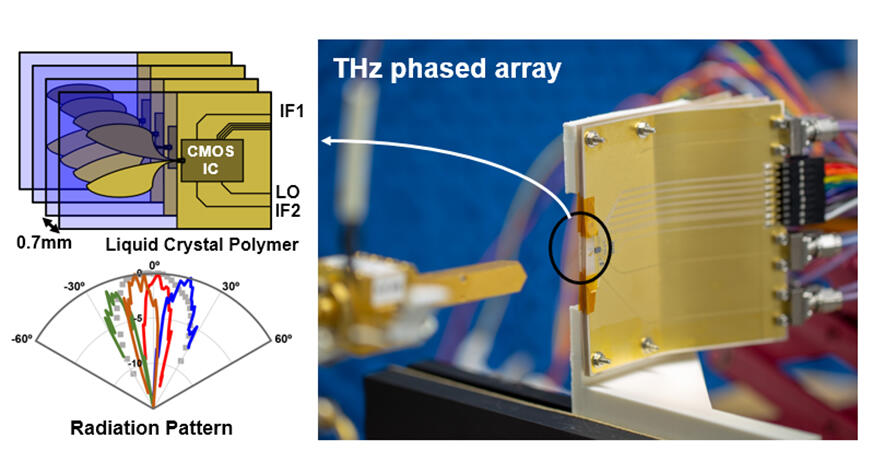Professor Kenichi Okada of the Department of Electrical and Electronic Engineering, School of Engineering, Tokyo Institute of Technology, and a research group from NTT have succeeded in developing a wireless device capable of communications in the terahertz range using an active phased array in a CMOS integrated circuit for the first time in the world. The terahertz band is expected to be used for the next generation wireless communications system that will come after 5G, and this achievement represents a major step towards the practical application of the technology.

The terahertz band wireless device that was developed consists of an integrated circuit manufactured using a silicon CMOS process that makes cheap mass production possible. Notably, the device uses a bidirectional sub-harmonic mixer that enables toggling of the same circuit between transmission and reception. The phased array antenna was achieved by creating an antenna pattern on copper foil on liquid crystal polymer circuit boards and then stacking four layers of thin CMOS integrated circuits.
The results of the experiment confirmed that wireless communications in the terahertz band was possible, and that the direction in which the signal was radiated could be changed using a control circuit. The details of the research were announced at the International Solid-State Circuits Conference 2021 held online on February 13.
5G services have been started both domestically and globally, representing the first time that the millimeter band has been used for major commercial services. While further advancement of the technology is certainly required, research on wireless communications beyond 5G is also heating up.
The terahertz band, which uses frequencies more than 10 times higher than the millimeter band used by 5G, is attracting particular focus in order to achieve faster and higher capacity wireless communications.
However, one issue faced with both the millimeter and terahertz bands is communications range. As the carrier frequency used for communications increases, the range over which communications can travel with a single antenna shortens in inverse proportions.
To solve this issue for 5G, active phase array technology, which combines multiple antennas in an array with the transmitter and receiver, is used to secure communications ranges of several hundred meters and more. In other words, increasing the number of antennas increases the communications range proportionately.
This means that the need for phased arrays is even greater for higher frequencies such as the terahertz band, and while it is also necessary to array antennas even more densely in proportion to the frequency, the communication device using active phase array technology for the terahertz band had not yet been achieved.
Accordingly, the researchers were able to achieve a phased array wireless device using the terahertz band by applying new techniques to the arrangement of the antennas and a higher density using a newly designed CMOS phased array integrated circuit.
While wireless devices using the terahertz band exist that use a single CMOS chip to function as either a single transmitter or a single receiver, the downside of these devices is the large surface area of the chips. In response, the researchers chose to use a bidirectional circuit and altered it so that it could be toggled between transmitter and receiver functionality.
Another challenge is that phase shifting must be applied to the signal transmitted and received by phased arrays. Accordingly, the team used the LO phase shifting approach capable of use with wide bands such as the terahertz band.
The team developed a prototype of the terahertz phased array integrated circuit using the 65nm CMOS process, and installed it in a small footprint phased array wireless device with dimensions of 1.7 mm x 2.45 mm. When a control circuit was installed in the integrated circuit to control the phase shifter, and the antenna's radiation pattern was measured, the team was able to confirm that beam steering according to the configured shift value was possible. The device consumes 0.75W for both transmission and reception.
Next, the team evaluated the device using wave modulation and found that the device could handle wave modulation methods including QPSK and 16QAM with modulation bandwidths from 242 to 280 GHz, and a maximum modulation speed of 52 Gbps (when using 16QAM) for the transmitter.
These results demonstrated that it is possible to use an active phase array for the terahertz band.
This article has been translated by JST with permission from The Science News Ltd.(https://sci-news.co.jp/). Unauthorized reproduction of the article and photographs is prohibited.




